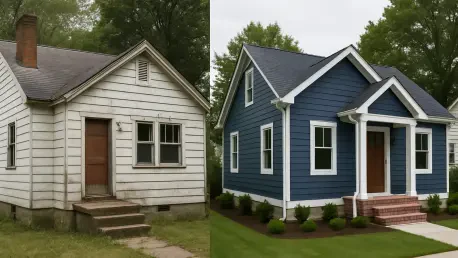Renovation has emerged as a defining force in the residential construction industry across the United States, fundamentally altering the landscape of how homes are improved, valued, and envisioned in today’s market. No longer just a secondary option to new builds, remodeling is carving out a central role, driven by a mix of economic pressures, shifting homeowner priorities, and evolving industry dynamics. This isn’t merely about sprucing up outdated spaces; it represents a structural pivot that’s reshaping business models, employment patterns, and market shares within the sector. Over recent decades, compelling data has underscored the growing dominance of renovation, positioning it as a cornerstone of residential construction. As challenges like affordability and aging housing stock mount, the focus on remodeling offers both practical solutions and promising opportunities for builders navigating an unpredictable economic climate. This exploration delves into the key ways renovation is driving change and what this means for the future of housing.
A Surge in Remodeling’s Industry Presence
The ascent of remodeling within residential construction marks a significant departure from traditional home building, reflecting a broader shift in industry priorities. Over the past 25 years, the number of firms specializing in renovation has nearly doubled, now accounting for over half of all businesses in the residential building construction sector. This remarkable growth isn’t just a fleeting trend but a response to persistent demand for updating older homes, especially as new construction often proves cost-prohibitive for many. Government data, including surveys like the Quarterly Census of Employment and Wages, highlights this trajectory, showing how remodelers have steadily gained ground. Their increasing presence signals a market recalibration, where updating existing structures often takes precedence over breaking ground on new ones, driven by both consumer needs and builders’ strategic adaptations to changing economic realities.
Beyond sheer numbers, the rise of remodeling firms reflects a deeper transformation in how residential construction operates as an industry. These companies, often outpacing traditional builders in market share, have become vital players in sustaining sector growth, particularly in times when new home projects stall due to financial or regulatory hurdles. Unlike the mid-2000s housing boom when remodelers held a smaller slice of the pie, their current dominance—representing over 56% of establishments—demonstrates resilience and adaptability. This shift is especially notable in the aftermath of economic downturns, such as the 2008 housing crisis, where remodelers weathered losses far better than their counterparts in new construction. The result is a restructured landscape where renovation isn’t just an alternative but a primary driver of activity, shaping investment decisions and redefining success for countless businesses in the field.
Key Factors Fueling the Renovation Wave
A confluence of economic and demographic factors lies at the heart of the renovation boom, pushing it to the forefront of residential construction. Chief among these is the aging U.S. housing stock, with many homes dating back decades and requiring significant updates to meet modern standards of safety, efficiency, and aesthetics. Coupled with this is the stark reality of affordability—new homes, burdened by escalating costs and stringent mortgage conditions, remain out of reach for a large swath of potential buyers. Renovation emerges as a practical workaround, allowing homeowners to enhance their current spaces without the hefty price tag of relocation or new construction. This demand is further amplified by builders who, facing volatile markets, pivot to remodeling projects as a steadier source of revenue, ensuring business continuity even when new builds slow down.
Another critical driver of this trend is the evolving mindset of homeowners who increasingly view renovation as a long-term investment rather than a temporary fix. With housing markets in flux and economic uncertainty looming, many choose to adapt their existing properties to suit changing needs—be it for remote work setups, energy efficiency upgrades, or expanded living spaces—rather than gamble on the uncertainties of buying new. This shift in perspective aligns with broader societal trends, such as sustainability concerns that favor retrofitting over sprawling new developments. Meanwhile, builders capitalize on this demand by offering tailored renovation services, often finding these projects less encumbered by the bureaucratic red tape that can delay or derail new construction. Together, these forces create a robust ecosystem where remodeling thrives as both a necessity and a strategic choice for all stakeholders involved.
Workforce and Market Dynamics in Flux
The ripple effects of renovation’s rise are vividly apparent in employment trends within residential construction, where remodelers now employ nearly half of the sector’s workforce—a dramatic increase from just a few decades ago. This shift has largely come at the expense of traditional single-family home builders, whose share of employment has significantly declined as remodeling firms prove more durable during economic slumps. The 2008 housing crash serves as a stark example: while new construction businesses shuttered at alarming rates, remodelers experienced only modest setbacks, quickly rebounding to claim a larger slice of the labor market. Today, with skilled production workers making up over half of remodeling employment, the sector’s influence on job creation and retention is undeniable, reshaping the industry’s human capital landscape.
Market dynamics further illustrate how renovation is redefining competitive edges in residential construction. Remodeling firms, often smaller and more agile, benefit from lower barriers to entry compared to the capital-intensive world of new builds. This accessibility allows new entrants and pivoting builders to tap into a growing pool of demand without the hefty upfront investments required for large-scale developments. Additionally, as consumer preference tilts toward personalized home improvements over cookie-cutter new constructions, remodelers are well-positioned to cater to niche needs, further solidifying their market foothold. Even amidst challenges like rising interest rates that dampen new home sales, renovation projects continue to flourish, underscoring a resilience that traditional builders struggle to match. This evolving balance of power signals a long-term reorientation of priorities within the industry.
Inherent Strengths of Renovation Over New Builds
Renovation holds distinct structural advantages over new construction, making it an increasingly attractive segment of the residential building sector. One key benefit is the reduced regulatory burden—remodeling projects typically face fewer permitting obstacles and zoning restrictions compared to the complex approvals often required for new developments. Additionally, the financial entry point for renovation is significantly lower, as it doesn’t demand the same level of land acquisition costs or large-scale infrastructure investments. Most remodeling firms operate with lean teams, averaging just three to four employees, which allows for operational flexibility and lower overhead. This small-scale model, consistent over decades, supports a nimble response to market shifts, positioning remodelers to thrive even when broader economic conditions challenge larger, more rigid construction entities.
Beyond operational ease, renovation benefits from a steady and diverse demand that insulates it from the volatility often seen in new home construction. Homeowners seeking to update kitchens, add energy-efficient features, or reconfigure spaces for modern lifestyles provide a constant stream of projects that don’t hinge on favorable mortgage rates or expansive housing booms. This consumer-driven momentum is complemented by the sector’s adaptability during downturns—unlike new builds that grind to a halt when financing tightens, remodeling often sees sustained activity as people opt to improve rather than move. The inherent stability of this approach not only ensures consistent workloads for firms but also fosters innovation in design and materials, as remodelers tailor solutions to specific client needs. Collectively, these strengths cement renovation as a robust and enduring force in reshaping how residential spaces are envisioned and maintained.
Looking Ahead: Sustaining the Renovation Momentum
Reflecting on the journey, renovation has carved a formidable path through the residential construction industry, establishing itself as a dominant force by overcoming economic challenges and adapting to homeowner demands. By 2024, remodelers had already captured over half of the sector’s businesses and workforce, a testament to their resilience during crises like the 2008 housing collapse and subsequent market fluctuations. Their ability to weather high interest rates and affordability barriers, which often stifled new construction, highlighted a unique strength that redefined industry standards.
Moving forward, sustaining this momentum requires a strategic focus on innovation and accessibility to keep pace with evolving needs. Builders should prioritize training programs to equip workers with skills for modern renovation techniques, ensuring quality and efficiency in projects. Additionally, policymakers could explore incentives to support sustainable remodeling practices, addressing aging housing stock while promoting energy efficiency. For homeowners, embracing renovation as a viable investment offers a pathway to enhance property value without the burdens of new purchases. These steps, taken collectively, promise to solidify remodeling’s transformative role in shaping the future of residential spaces.









